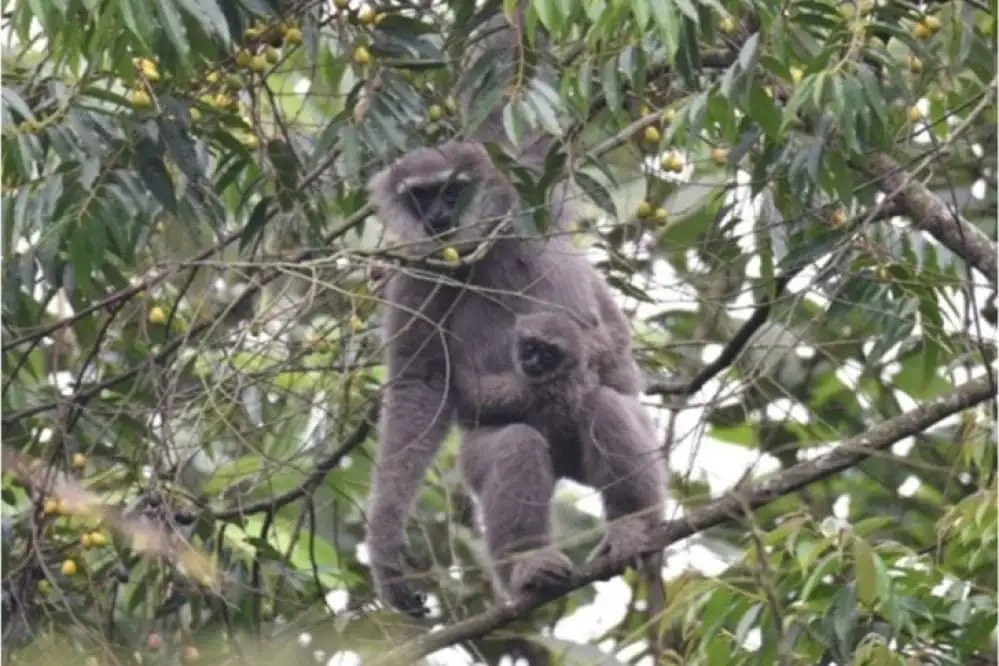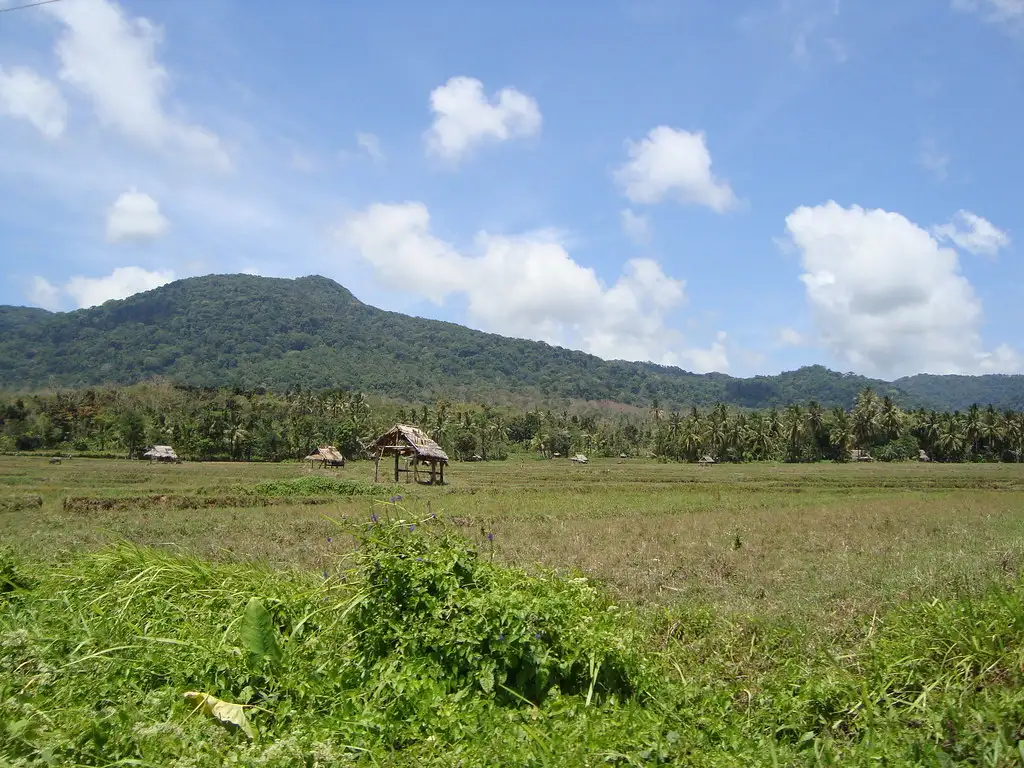Gunung Honje, located on the eastern side of Ujung Kulon National Park, is a mountainous region that offers a striking contrast to the park’s lowland forests and coastal landscapes. Rising over 600 meters above sea level, its slopes are blanketed with dense dipterocarp forests, bamboo groves, and lush undergrowth that support an impressive variety of wildlife, from javan gibbons (hylobates moloch) and leaf monkeys to hornbills and peafowls.
Unlike the rhino-dominated peninsula, Gunung Honje is also home to local communities whose villages and farms border the forest, creating a dynamic landscape where rich biodiversity and traditional culture coexist.
Geographic and Ecological Setting
Gunung Honje stretches along the eastern side of Ujung Kulon National Park, separated from the peninsula by narrow lowlands and rivers. Unlike the flat coastal and swampy terrain of the park’s western parts, this area is hilly and mountainous, with elevations reaching more than 600 meters above sea level. The topography creates a distinct ecological gradient—from mangrove forests near the coast to dense lowland dipterocarp forests and hill forests higher up.
The variation in elevation and habitat makes Gunung Honje a biodiversity hotspot within the park. While the peninsula is world-renowned for harboring the last population of the Javan rhino, Gunung Honje provides complementary habitats that support a wide range of plant and animal species.
Flora Diversity
The forests of Gunung Honje are dominated by large dipterocarp trees, evergreen tropical hardwoods that form the backbone of Southeast Asian rainforests. Tall species like Shorea, Dipterocarpus, and Hopea tower above the canopy, providing food and shelter for countless species.
Other vegetation includes bamboo clusters, rattan, and a rich variety of understory plants such as ferns and wild ginger. Because of the hilly terrain, many plants here are adapted to steeper slopes and higher rainfall compared to the lowland swamps of the peninsula. These forests are crucial for watershed protection, supplying fresh water to surrounding communities and regulating the flow of rivers that pass through the region.
Fauna of Gunung Honje
While Gunung Honje is not the main refuge for the Javan rhinoceros—most rhinos prefer the lowland and swampy habitats of the peninsula—it is still home to a rich diversity of wildlife. Leopards, wild boars, barking deer, Javan lutungs (black leaf monkeys), and silvery gibbons roam the forests. Birdwatchers will find Gunung Honje especially rewarding, with species such as hornbills, green peafowls, Javan hawk-eagles, and various kingfishers inhabiting its dense canopies.

The presence of such fauna indicates the area’s relatively intact ecosystem, though it faces ongoing pressure from human activities. In fact, Gunung Honje acts as a buffer zone between the fully protected park and the villages surrounding it, making it both biologically rich and socially complex.
Human Settlements and Cultural Aspects
Unlike the strictly protected peninsula, Gunung Honje is surrounded by—and in some parts, interspersed with—human settlements. Several villages are located in or near the Gunung Honje area, with residents primarily engaged in farming, fishing, and small-scale forest resource use. Communities here grow rice, coconuts, cloves, and other crops, while also depending on the forest for timber, firewood, and medicinal plants.
This interaction between humans and the natural environment has shaped a unique cultural landscape. Many local people hold traditional knowledge about forest plants, wildlife behavior, and natural cycles. At the same time, pressure on land and resources has historically led to conflicts between conservation goals and community needs.
To address this, park authorities and NGOs have worked on community-based conservation programs, promoting eco-tourism, agroforestry, and sustainable fishing as alternatives to extractive practices. These efforts are crucial, as the long-term survival of both the park’s wildlife and the local way of life depends on striking a balance between protection and sustainable use.
Conservation Challenges
Gunung Honje faces a number of conservation challenges, including:
- Deforestation and Encroachment – Some parts of the mountain have been cleared for farming or settlements, reducing forest cover and fragmenting wildlife habitats.
- Illegal Logging and Hunting – Despite regulations, illegal resource extraction remains a problem, driven by local economic needs.
- Human-Wildlife Conflict – Farmers sometimes experience crop damage from wild boars or monkeys, creating tensions with conservation authorities.
- Limited Accessibility and Monitoring – Compared to the rhino habitat in the peninsula, Gunung Honje has fewer patrols and research activities, making enforcement of conservation laws more challenging.
Nevertheless, the area is recognized as a vital component of Ujung Kulon’s ecosystem. Protecting Gunung Honje not only helps safeguard biodiversity but also supports the livelihoods of surrounding communities.
Tourism Potential
Although less famous than the peninsula and Peucang Island, Gunung Honje offers exciting opportunities for eco-tourism and adventure travel. Hiking trails wind through dense forests, past rivers and waterfalls, and up to scenic viewpoints overlooking the park and the Sunda Strait. For travelers seeking a more immersive experience away from the typical beach-and-boat tours, Gunung Honje provides a refreshing alternative.
Potential activities include:
- Trekking and Birdwatching – Exploring the forested slopes in search of hornbills, gibbons, and rare flora.
- Cultural Tourism – Visiting local villages to learn about traditional farming, fishing, and crafts.
- Community-Based Homestays – Staying with local families to support village economies while experiencing authentic rural life.
However, tourism development here must be carefully managed to avoid repeating the mistakes of mass tourism elsewhere. Low-impact, small-scale eco-tourism is key to ensuring that tourism contributes positively to both conservation and local welfare.
The Future of Gunung Honje
As Indonesia continues its efforts to protect Ujung Kulon National Park, Gunung Honje will play an increasingly important role. While it may never host a large population of Javan rhinos, its forests are critical for maintaining biodiversity, regulating water systems, and serving as a living space for local communities.
The challenge lies in integrating conservation, community development, and sustainable tourism into a coherent strategy. With proper management, Gunung Honje could become a model for how protected areas and human settlements can coexist productively.
The Gunung Honje area of Ujung Kulon National Park is often overshadowed by the peninsula’s fame as the last sanctuary of the Javan rhinoceros. Yet this mountainous region is rich in biodiversity, cultural heritage, and ecological importance. Its forests protect watersheds, shelter rare wildlife, and sustain local communities.
By balancing conservation with community needs and promoting responsible eco-tourism, Gunung Honje can emerge as a vital part of Ujung Kulon’s identity—not just as a buffer zone, but as a destination and conservation priority in its own right.

